Have you noticed a little more chatter on the inter webs these days about whitework embroidery?
I think 2019 might be the Year of Whitework.
I’ve seen quite a few embroiderers discussing whitework lately on social media. Thistle Threads is offering an intense online class on 17th century whitework samplers starting this year. I’ve received half a dozen inquiries about this whitework instructional book recently.
And I’ve been playing with whitework ideas lately, too.
Once in a while, the whole notion of pristine white-on-white embroidery beckons me irresistibly. And the call has been strong in the last month or so!
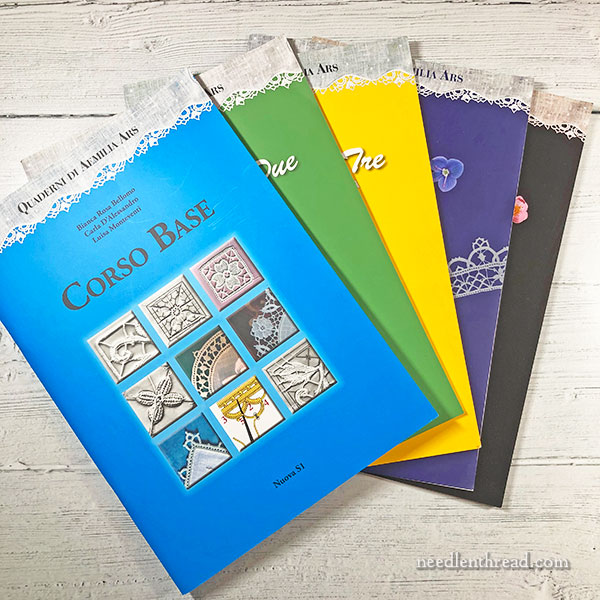
Along with the strong appeal of whitework these days, there’s this set of books. They were a Christmas present. And I think you deserve to know about them!
This is a set of instructional books for Aemilia Ars, which is an Italian needle lace technique.
As Italian needle laces go, Aemilia Ars is a relatively new kid on the block – developing in the latter part of the 19th century – but its roots stretch back to the Italian needle laces of the Renaissance.
Needle lace and whitework go together, and Aemilia Ars is a beautiful form of needle lace that is relatively easy to learn. It employs stitches most embroiderers already know, making heavy use of the buttonhole stitch and various detached fillings.
There are, to my knowledge, six books in this collection written by Blanca Rosa Bellomo, Carla D’Alessandro, and Luisa Monteventi. Three are devoted to learning the technique in graduated practice pieces, and the other are stand-alone books that focus on borders, on floral motifs, and on classical fruit designs. I haven’t received the fruit book yet, but it’s a-comin’!
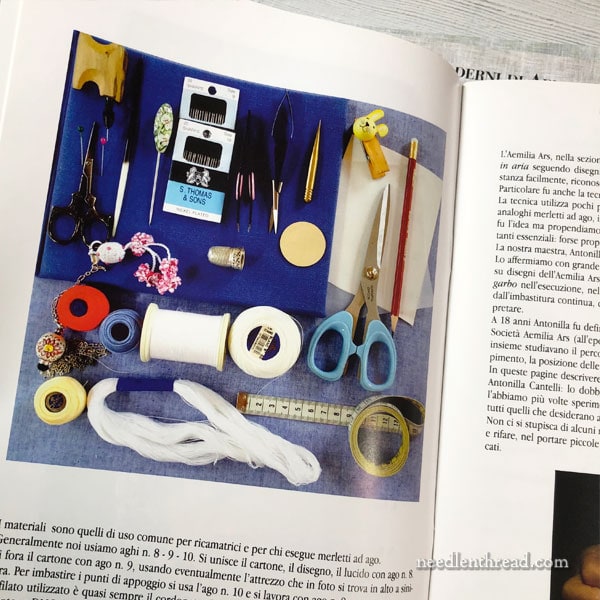
The books are in Italian, but if you don’t read Italian, that’s ok. They are packed with clear photos that tell you pretty much everything you need to know.
Anything you get stuck on, never fear – Google is your friend in this case, and a quick search of the term either through a translation app or a search engine will bring you the enlightenment you seek.
You can see from the photo of the supplies that there’s not really anything here that’s exotic or strange. Cotton threads, needles, pins, scissors … they’re fairly universal supplies for any needlework!
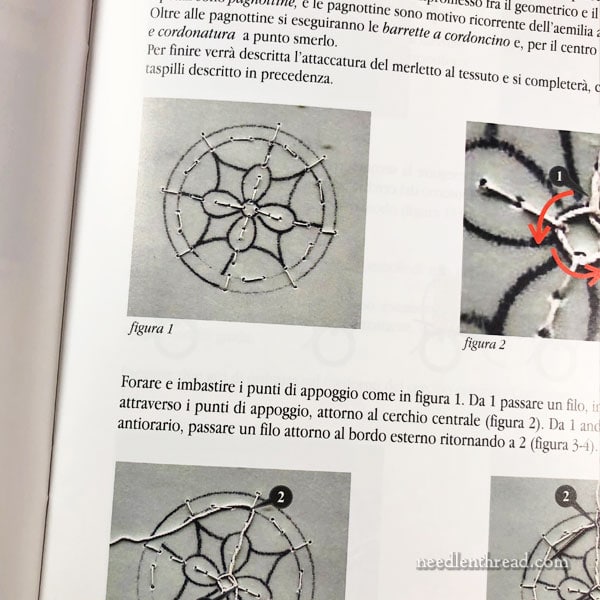
As far as the instructions are concerned, the step-by-step photos speak for themselves.
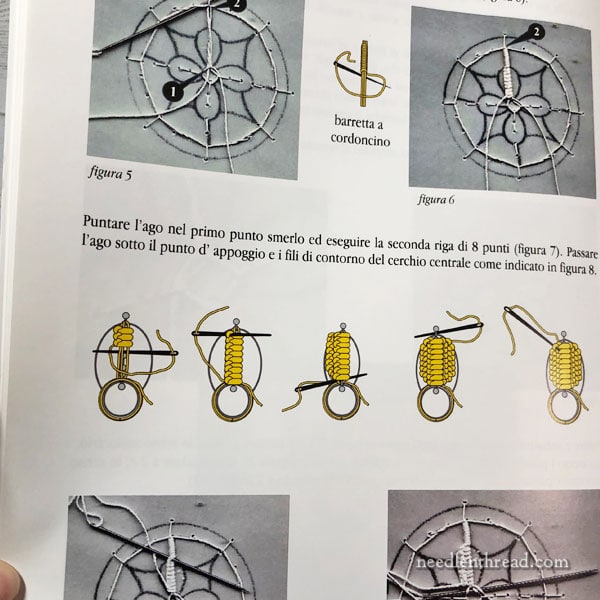
And whenever a little clarification is necessary, it comes in the form of very clear diagrams that show the movements of stitches, the orientation of thread to needle, and all the needful information for working the technique.
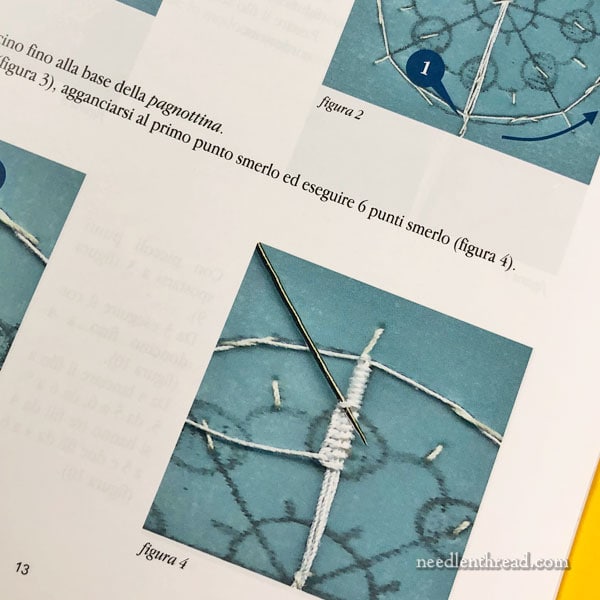
I can’t take you through every book in the collection in one article, but suffice it to say that all the books are equally clearly photographed.
They come with drawn designs to use as practice projects, and they walk you through the process of working the designs.
The “Course 1 – 3” books are excellent for learning the basics of Aemilia Ars through incremental steps that develop your skill as you progress through the books.
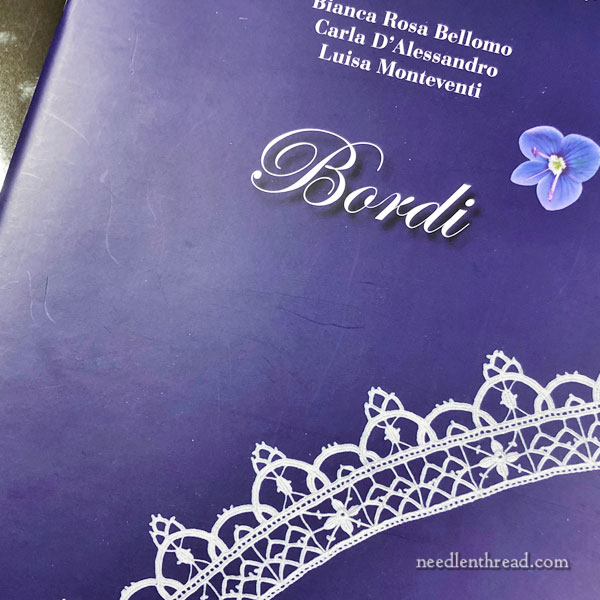
This is one of the stand-alone books, focusing on needle lace borders. This particular books initially attracted me to this collection.
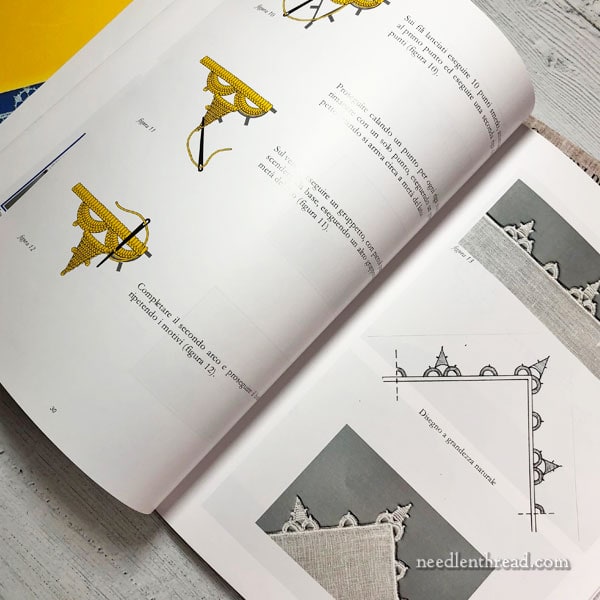
Like the course books, it is full of clear diagrams and photos for creating beautiful needle lace borders on the edges of linens and the like.
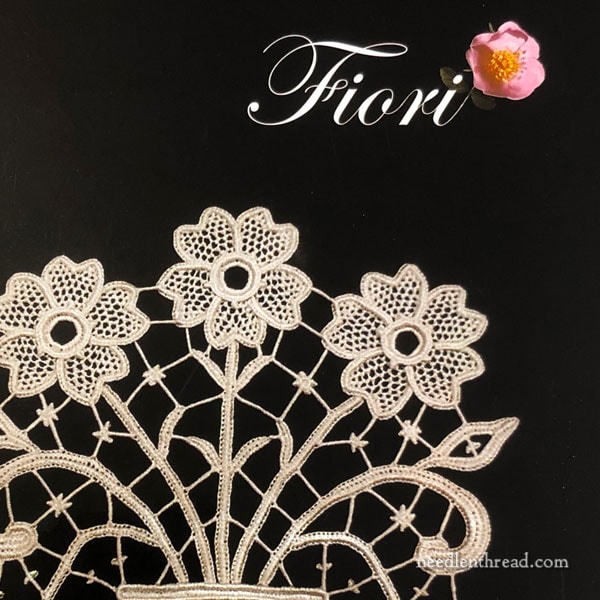
The other stand-alone book that I have right now focuses on floral motifs that can be used as inserts on linens or as stand-alone needle art.
Then there’s the Frutti Classici book, which I don’t have yet. It promises to focus on fruit motifs.
Where to Find Them
Where to find the books is a bit tricky, depending on where you live.
Check out the inventory at Lacis in California. They carry a very wide range of lace-related and embroidery-related books from all over the world. If you search their online catalog for “Aemilia Ars,” these books will show up in the results. Unfortunately, their website is a bit nutty – I can’t link directly to any individual listing.
Through Amazon, this link will take you to a list of whatever books are available on Amazon on the subject.
In Australia, it looks like Alison Cole carries the first two of the course books.
You can also go to Amazon Italy and search “Aemilia Ars” and most of these books come right up in the results. I’ve not ordered from Amazon in Italy, but you’ll definitely want to do a currency conversion first and check on shipping costs before placing an order if you don’t live in Italy.
This article contains an affiliate link to Amazon, which means that any purchase made through that link results in a small commission for Needle ‘n Thread with no extra cost to you. Thank you!







Dear Mary
Funny you should write an article on whitework I’m actually stitching a practice piece the the free pattern you showed in 2016 Easter Bunny by Haft Richelieu. It’s a lovely piece but quite a bit to it, I’m learning how to buttonhole circles which I’m finding difficult, it’s a bit like satin stitch it takes a while to learn how to even out the stitches. The books look lovely and full of wonderful whitework pieces the floral lace motifs look interesting I would love to try that. I have the RSN Whitework book which is great. Thanks for reviewing and sharing with us the Aemilia Ars books they look really interesting. I hope you have a great weekend.
Regards Anita Simmance
Mary, you temptress! Thank you for sharing those books.
Through Needle ‘n Thread I have grown to love whitework. The book you are being questioned about, the RSN whitework guide by Lizzy Lansberry, has given me superb instruction, and once again I am beholden to you for introducing me to it. It would be wonderful to follow along with a whitework project here.
Another great book on whitework is “Contemprorary Whitework” by Tracy Franklin and Nicola Jarvis – all the basics but then on to more experimental pieces.
These books are also available in the USA from Van Sciver Bobbin Lace (http://www.vansciverbobbinlace.com/1Books.html). I had the pleasure to take a class in Bologna with the authors, who are wonderful, warm, and full of enthusiasm for Aemilia Ars lace!
The books can be had from Amazon also. They ship from amazon UK.
I just checked for those books at The Book Depository, and it says that only 1 of the 4 is available. Ratz! I was going to add to my library……..
Mary, I did go back to the site using your links and purchased the one available- Fiori . I look forward to seeing all the floral designs!
These books look good! Not easy to obtain!!
I have one in my collection, Il Punto Antico – Un bored aemilia ars. It is in Italian, but also has the English translation.
On my list of “To Do”.
Books, books, books, they drive me nuts. I love embroidery books and keep buying new ones and just received Whitework with colour (Trish Burr)Crewel creatures (Hazel Blomkamp), The embroiderer’s Little Book of Hints&Tips (Alison Cole) and Les Broderies de Marie & Cie, Le blanc tradition, Les éditions de saxe for Christmas and my birthday.
I spend so much time looking at all those beautiful projects dreaming about all those I should start.
And there is too that wonderful Inspiration magazine that I finally registered to even though it is so expensive.
I want to do the gorgeous embroidered book “Monet, Hugo et les poissons” for my grand daughter. But now, I look at what you are presenting today, and it make me drool with envy. I love Whitework.
How can I manage to do everything with my UFO’s, the visits that I have to carry (and that I love to do) as a volunteer guide at Jardin botanique de Montréal, my love for cross-country skiing and my involvement in the executive of our 122 members’ club, visiting and taking care of my very old and sick parents, occasional babysitting of my 2 year old grand- daughter.
I have retired 6 years ago and since then, time flies… I need 48 hours days.
I might order those books and ask my husband to put them under the Christmas tree next December because I love Whitework and would like eventually to start a new technique.
The first book is already sold out at Book Depository. Mary, you talk too much… Everybody s rushing to buy. 😉
Hi, Mary – I got my set of these Aemilia Ars books from Maria Provencher last year. She too may have some copies available for your readers. Fascinating technique. Don
Those particular books can be found at VanSciver Bobbin Lace at http://www.vansciverbobbinlace.com/ which would support another small business. Look under Books, then under Needlelace. There is another book: Punti Base – Garofano Videomanuali di Aemilia Ars (or it must be a video?).
And I will add that I would love for you to do some videos of the different stitches in Aemelia Ars! Those books may be detailed, but I can’t seem to get the picots!!
You have touched upon one of my most favorite topics — Italian needlelace.
The books you mentioned above are terrific. You are correct, the detailed pictures compensate for not knowing Italian. They also have a DVD out. It is in Italian but has English dubbed (or at least subtitled). I could not play it on my DVD player here in the US (due it it being a different country code maybe?). But I have been able to play it on my personal laptop.
I purchased it (and other books) at http://www.tombolodisegni.it. Look under Libri, then Libri Merlatto Ad Ago.
I had issues with the one particular stitch. But Margaret Stephens has a book called Embroidered Lace which was helpful. I see she has another book out I need to check out — Geometrical Needlelace in the Style of Amelia Ars.
Oh, so tempting! (Slaps wrist and looks at stash of projects-in-waiting.) I’ve bookmarked Alison Cole’s page – meanwhile, please remember to show us your own WIP in this beautiful technique.
Hi Mary, there is also a book on four small borders in this series. As far as I know the publisher takes orders directly (and he speaks English) http://www.nuovas1.it/e-shop/merletti-e-ricami/quattro-bordini-aemilia-ars/
Thanks, Jeanine! That’s great to know!
Hi Mary—I hope this means that a whitework project is bubbling up in your studio & will shortly appear on NeedlenThread! As chance would have it, I recently ran across an exquisite piece online while looking for something else. V&A has a “search collections” feature on their site. The piece is 401 – 1907 Cover, English whitework circa 1705. The stylized birds & fanciful flora are eyepopping. I was looking for bobbin lace & this item came up because it is trimmed in BL. Serendipity!
The staff at Lacis is very helpful. If you can’t find an item on their website give them a phone call and someone will be happy to check the stock for you.
I’m currently resisting buying any of these books as I have enough projects in my sewing room now to last two lifetimes and should really not start on a completely new technique until I’ve finished at least two unfinished projects. Right? …
Mary, you are killing me. Another kind of whitwork that I feel I HAVE to learn. Oh my! It is so beautiful!
Well it looks like 2019 is going to be a very enjoyable year if that is the case! Whitework embroidery techniques are very close to my heart. I have seen Amelia Ars embroideries floating around on Pinterest, but know very little about it so I will be fascinated to watch your progress with these books. I can see why you like the border designs particularly, there will be so many cross over uses for embellishing or coordinating with other embroidery projects and techniques. I have bookmarked the borders volume for my reading list!
I finaly ordered the first three books a few weeks after you published your review, from Book depository, which was the easiest way for me from Canada. I haven’t started yet to do anything yet but I intended to do so in a not so far future. But looking at the first book I see that it is not so easy to follow the instructions with the photos.
For exemple on page 10, you see two threads (filo guida and filo di inizio) but we do not see where the start from. And the piece seems to be stitch to something rigid while the embroidery is being done (figura 4, figura 7 and so on). How is it done?
Same in page 17, we see in figura 1 the design and threads that seems to serve as anchor to the work. Where are they done? On what kind or surface.
I am a French speaker, so written Italian can be in part understood. But nowhere do I see instructions about what is the base of that work.
Can you help me with that?
To follow with my previous message, I just see the page where she is explaining about using a cardboard. I think I will use google translation to translate every single page before starting. It isn’t perfect in terms of embroidery but better than nothing. At the end, I will have learned a lot of words in Italian.
Hi, Louise – Elisabetta has a blog, here: https://elisabettaricami.blogspot.com, which you can tell Google to translate the English edition (and probably other languages, too). She has contact information on her blog, and she does speak English, so you could drop her a line and ask her directly, too, if you wish. I don’t have my book with me at present, so I can’t look up the pages you’re referring to right now.
An update: Jeanine Robertson (comment above) has graciously translated the first three books in the series into English. (I’m secretly hoping she does the rest, as well.) I was able to purchase them from Lacis, as you mentioned. And when it appeared that the post office had lost them, Perrin at Lacis was so incredibly helpful in working with me to track them down, assuring me that if all else failed, they would reship them. Thankfully that wasn’t needed, as the books finally arrived a few days later.